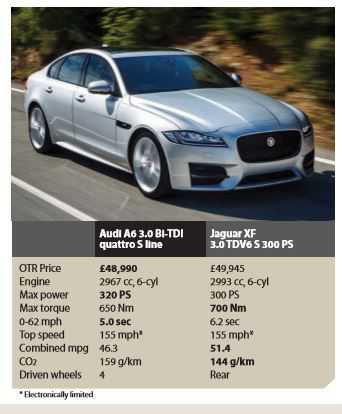Jaguar XF versus Audi A6
ORIGINALLY launched in 2008, the Jaguar XF has been highly successful, mixing it with the previously dominating Audi A6, BMW 7-Series and Mercedes E Class. Not content to rest on its laurels, though, Jaguar has created a completely new XF which is lighter, more efficient and packed with technology. Considering it is a much smaller company than any of the German premium brands, Jaguar has done a remarkable job in making the new XF even better than its competitors, particularly in respect of quietness, refinement and handling fluidity. The aluminium-intensive architecture is responsible for weight saving, around 80 kg lighter than the competition and, with the 2.0-litre diesel engine, the lowest claimed CO2 emissions of any non-hybrid model in the segment: 104 g/km of CO2 and 70.6 mpg combined fuel economy. The exterior design changes also contribute to lower emissions and better fuel economy with an exceptional aerodynamic efficiency: Cd 0.26. The changes also increase interior room, segment-leading for rear seat space: row-two occupants gain 15 mm more legroom, 24 mm more knee room and 27 mm more headroom. The all-new 10.2-inch touchscreen infotainment system, InControl Touch Pro, offers door-to-door navigation, seamless iOS and Android connectivity and 17-speaker, 825W Meridian digital surround sound while a reconfigurable 12.3-inch TFT instrument cluster features four visual themes and full-screen navigation display. Powertrains range from the new four-cylinder 163 PS Ingenium diesel and 6-speed manual to 380 PS V6 supercharged petrol and 8-speed automatic transmission. In between is the 3.0 TDV6 tested here, which despite being uprated by 25 PS and 100 Nm of torque actually has better economy and lower emissions than its predecessor. With a claimed 51.4 mpg and 144 g/km on the combined cycle instead of 44.8 and 169, this efficiency improvement is most impressive. The double-wishbone and Integral Link suspension deliver exceptional ride comfort, handling, and unrivalled refinement and there is an All-Surface Progress Control enabling smooth, effortless drive-away on low-friction surfaces such as snow and ice; all the driver has to do is steer. The all-new XF offers a host of additional technology including full-LED headlights, a laser head-up display which delivers highcontrast colour images, autonomous emergency braking, adaptive cruise control with queue-assist, lane keep-assist, intelligent speed limiter and semi-automated parking. When I first drove the Audi A6 BiTDI with its 320 PS, I was blown away by its power, silky smoothness, quietness and refinement. I wouldn’t then have believed that any other manufacturer could do it better until, a few weeks ago, I drove Jaguar’s take on the twin-turbo, six-cylinder diesel approach. Wow, it is just amazing that a small manufacturer like Jaguar Land Rover can create such a superb engine. Despite coming after the Audi’s twin-turbo, Jaguar, for some reason, has limited the power output to 300 PS against Audi’s 320. This difference shows up in the specification sheets with the Audi’s 0-62 mph figure 1.2 seconds quicker at an impressive 5.0 seconds, but this doesn’t show up on the road, the XF’s extra torque coming through in cross-country driving.

Jaguar knew that it would be difficult to make a better executive interior than BMW, Mercedes and particularly Audi and so tried to do something different. The first time you enter an XF and start the engine you may be impressed with the air-conditioning vents that automatically open and the gear control knob which rises eerily from the centre control but these are gimmicks involving motors which will surely fail at some point when the car is out of warranty. They add nothing to the useability or enjoyment of the vehicle apart from impressing relatives and friends the first time they travel with you. Don’t get me wrong, the interior of the Jaguar XF is a very pleasant place in which to be a driver or passenger, with extremely comfortable seats and all the controls where they should be. The driving position is perfect, with a full range of seat adjustments. In the final analysis Jaguar hasn’t quite reached Audi’s interior standards of fit and finish. One day, one of the premium manufacturers will shade Audi but it hasn’t happened yet. Coming from behind, Jaguar has made a major step in the premium market on depreciation: the Jaguar XF retains a larger percentage of its new price after three years and 60,000 miles, the standard fleet measure, than its German and Japanese competitors. As leasing and private contract purchase rates depend on depreciation, this will help the XF to grow market share. Also the XF will suffer lower Benefit-in-Kind tax rates than its rivals. The only disadvantage of the XF is its lack of four-wheel drive, although this is only apparent in slippery conditions. In the dry the rear-wheel drive Jaguar offers more responsive handling and steering than the A6 but unfortunately we have a lot of rain in this country. A four-wheel-drive XF is, thankfully, on the way.
